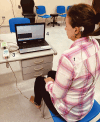Galvanic vestibular stimulation to rehabilitate postural instability in Parkinson's disease
- PMID: 40262810
- PMCID: PMC12020501
- DOI: 10.1055/s-0045-1806812
Galvanic vestibular stimulation to rehabilitate postural instability in Parkinson's disease
Abstract
Background: Galvanic vestibular stimulation (GVS) is a non-invasive technique employed to rehabilitate balance by delivering low-intensity, short-duration electrical stimulation to the mastoid bones, effectively activating the vestibulospinal tract.
Objective: To evaluate the effects of GVS on balance in patients with Parkinson's disease (PD) and postural instability.
Methods: In this clinical study, 25 PD patients with postural instability in the ON phase (best effect of dopaminergic medication) underwent GVS. Balance was assessed using the Berg Balance Scale (BBS), the Timed Up and Go (TUG) test, and posturography on a force platform. Electrical current intensity was progressively increased between the mastoids, starting at 1.0 mA and reaching 3.5 mA by the 6th session, with this level maintained until the 8th session. Stimulation duration began at 9 minutes in the 1st session, increased to 30 minutes by the 3rd session, and was sustained through the 8th session.
Results: A blinded comparison of pre- and post-GVS evaluations demonstrated significant improvements in BBS (p = 0.00001) and TUG (p = 0.00003) scores. Posturography showed an increase in the stability limit area (p = 0.026) and the general balance index (p = 0.001).
Conclusion: In the therapeutic management of postural instability in PD, GVS emerges as a promising complementary strategy for enhancing balance. Further research is needed to determine whether these improvements persist after GVS cessation.
Registration of clinical trial: https://ensaiosclinicos.gov.br/rg/RBR-22j8728.
The Author(s). This is an open access article published by Thieme under the terms of the Creative Commons Attribution 4.0 International License, permitting copying and reproduction so long as the original work is given appropriate credit (https://creativecommons.org/licenses/by/4.0/).
Conflict of interest statement
The authors have no conflict of interest to declare.
Figures



Similar articles
-
Functional brain activity in persistent postural-perceptual dizziness (PPPD) during galvanic vestibular stimulation reveals sensitization in the multisensory vestibular cortical network.Sci Rep. 2025 Jul 27;15(1):27355. doi: 10.1038/s41598-025-11529-2. Sci Rep. 2025. PMID: 40717118 Free PMC article.
-
The effects of myofascial release in combined with task-oriented circuit training on balance in people with Parkinson's disease: a randomized pilot trial.Neurol Res. 2024 Sep;46(9):848-858. doi: 10.1080/01616412.2024.2360860. Epub 2024 May 31. Neurol Res. 2024. PMID: 38818769 Clinical Trial.
-
Exercise for improving balance in older people.Cochrane Database Syst Rev. 2011 Nov 9;2011(11):CD004963. doi: 10.1002/14651858.CD004963.pub3. Cochrane Database Syst Rev. 2011. PMID: 22071817 Free PMC article.
-
Physiotherapy versus placebo or no intervention in Parkinson's disease.Cochrane Database Syst Rev. 2013 Sep 10;2013(9):CD002817. doi: 10.1002/14651858.CD002817.pub4. Cochrane Database Syst Rev. 2013. PMID: 24018704 Free PMC article.
-
Depressive symptoms can negatively influence patient reported disease severity after subthalamic nucleus stimulation for Parkinson's disease.J Parkinsons Dis. 2025 Aug;15(5):998-1006. doi: 10.1177/1877718X251354933. Epub 2025 Jun 26. J Parkinsons Dis. 2025. PMID: 40567008
References
MeSH terms
LinkOut - more resources
Full Text Sources
Medical
Research Materials
Miscellaneous

